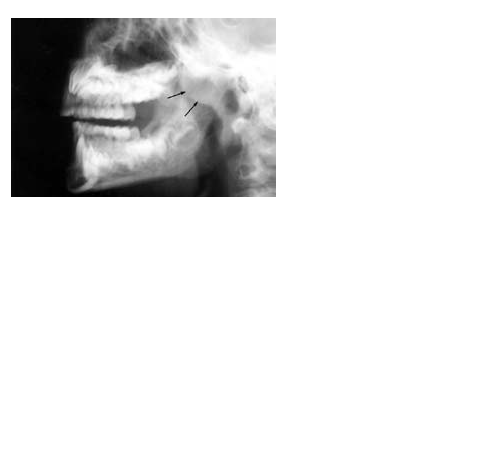
Adenoids
The adenoid mass of lymphoid tissue is situated on the posterior wall of the
nasopharynx and occupies much of that cavity in young children. At the age
of about 6 or 7 years atrophy commences and, as a rule, by the age of about
15 years little or no adenoid tissue remains. In some children of 1–4 years
of age, the adenoids, as a result of repeated upper respiratory infections,
undergo hypertrophy with the following ill-effects.
Nasal obstruction
Nasal obstruction becomes established and results in:
1 mouth breathing—the mouth is dry and constantly open;
2 recurrent pharyngeal infections;
3 recurrent chest infections;
4 snoring and disturbed sleep—in severe cases, episodic sleep apnoea
may occur.
Eustachian tube
Eustachian tube obstruction predisposes to:
1 recurrent acute otitis media;
2 secretory otitis media with deafness;
3 chronic suppurative otitis media (CSOM).
DIAGNOSIS
The nasal obstruction and mouth breathing are apparent, and the history
will confirm the features mentioned above. Diagnosis of enlarged adenoids
as the cause of the symptoms is confirmed by mirror examination (Fig. 27.1)
or by lateral soft tissue X-ray (Fig. 27.2).
TREATMENT
Adenoidectomy is curative if the case has been selected properly. In children
with enlarged adenoids and recurrent aural disease, early adenoidectomy
is of supreme importance.
Adenoidectomy is carried out under general anaesthesia with endotracheal
intubation. An adenoid curette is swept down the posterior pharyngeal
wall, taking care to remove all remnants of lymphoid tissue. Brisk bleeding usually stops rapidly and the patient remains in the recovery area
until fully awake with no persistent bleeding.
COMPLICATIONS
1 Haemorrhage—this usually occurs in the first 24 h. Do not delay in
setting up a drip, getting blood cross-matched and returning the child to
theatre. Delay may be fatal. A postnasal pack is inserted under general
anaesthetic after first making sure that there are no tags of adenoid tissue
left.
2 Otitis media.
3 Regrowth of residual adenoid tissue.
4 Rhinolalia aperta. Removal of large adenoids in a child with a short soft
palate may result in palatal incompetence, with nasal escape during speech.
Resolution usually occurs, but if it does not, speech therapy is advisable.Rarely, pharyngoplasty is necessary.


